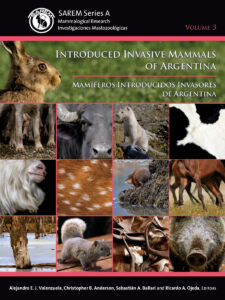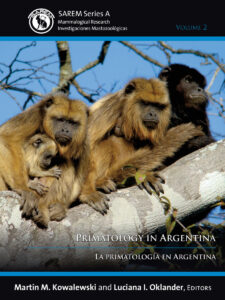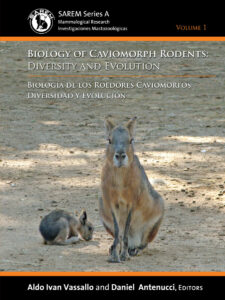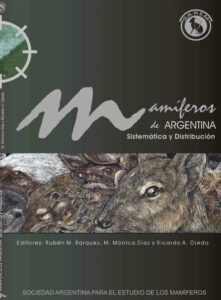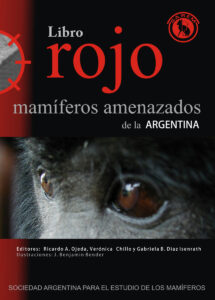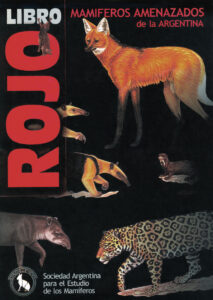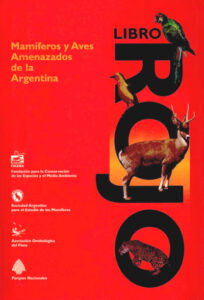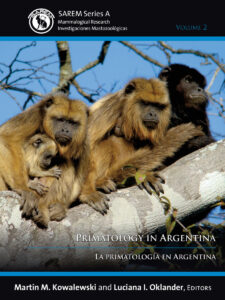These are the books published by SAREM. You may download some of them for free in PDF format from this page, and also acquire printed copies.
Besides online purchase by credit card (Visa, MasterCard or American Express), any purchase can be made via wire transfer or bank deposit to the following SAREM account:
SAREM Current Account
BBVA Frances Bank
No. 20-475-001298/6 (Beneficiary Account)
BRN: 0170475820000000129864
Tax ID Number: 33-70782409-9
Please notify SAREM’s Treasury of the payment or transfer. You will later coordinate the delivery of the purchased items with them.
Click on a cover to see details
Despite having one of the longest histories of mammalian research on the South American continent, Paraguayan mammalogy remains under-developed due to a lack of trained researchers and opportunities for study, and cultural under-valuation of biological sciences. While this situation is improving with government investment in scientific endeavor, capacitation of educators and greater societal awareness of environmental issues, Paraguay still lags behind its neighbors in the production of zoological literature, and mammalogy is no exception.
This review aims to provide a succinct overview of the current state of knowledge about Paraguayan mammals and mammalogy. We hope this monograph will provide a detailed and solid framework for ongoing work and serve as a stimulus for future research.
Contents
Chapter 1. Physical parameters
Chapter 2. Mammalian paleontology in South America and Paraguay
Chapter 3. Ecoregions, ecosystems, hot spots, protected areas
Chapter 4. History of Mammalogy in Paraguay
Chapter 5. Paraguayan mammals in museums
Chapter 6. Gazetteer of mammal collection localities in Paraguay
Chapter 7. Keys to the orders and families of Paraguayan mammals
Edited by Alejandro Valenzuela, Christopher Anderson, Sebastián Ballari and Ricardo Ojeda, and with the contribution of 49 specialists in the field, this volume is the first book exclusively dedicated to biological invasions by mammals in Argentina.
Although in Argentina there have been a large number of initiatives related to the study and management of Introduced Invasive Mammals (IIMs), this book is the first work that brings together the different aspects of the subject for our country, including conceptual and applied contributions, providing rigorous, relevant and legitimate information to support research, management and the definition of public policies.
In the first section, the book presents a series of chapters that put into context priority topics related to the conceptualization and implementation of research and management of IIM. Then, in the second part of the book, we include fact sheets with updated information on all the species of IIM present in Argentina.
This work is a contribution that reinforces the National Strategy on Invasive Alien Species and the implementation of the new 2030 Global Biodiversity Framework of the Convention on Biological Diversity, which contains specific goals to reduce species introductions and promote the management and eradication of established invasive species.
Contents
Foreword
Daniel SIMBERLOFF
Chapter 1. Introduced and invasive mammals: conceptual and historical perspectives for Argentina
S. Yasmín BOBADILLA, Andrea del Pilar TARQUINO-CARBONELL and Ricardo A. OJEDA
Chapter 2. Reconceiving biological invasions as a socio-ecological phenomenon using the case study of beavers in Patagonia
Christopher B. ANDERSON and J. Cristóbal PIZARRO
Chapter 3. Charisma as a key attribute for the expansion and protection of squirrels introduced to Argentina
M. Laura GUICHÓN, Mariela BORGNIA, Verónica BENÍTEZ and A. Cecilia GOZZI
Chapter 4. Hunting as a driver of mammal introductions
Sebastián A. BALLARI, M. Noelia BARRIOS-GARCÍA, Javier SANGUINETTI, Hernán PASTORE and M. Fernanda CUEVAS
Chapter 5. Impact of introduced invasive herbivores in Patagonian forests
M. Noelia BARRIOS-GARCÍA, Carolina QUINTERO, Yamila SASAL, Sebastián A. BALLARI, Agustín VITALI and Mariano A. RODRÍGUEZ-CABAL
Chapter 6. Management of feral horses as invasive mammals: biodiversity conservation versus culture?
Alberto L. SCOROLLI
Chapter 7. Progress of biological invasion genetics and the management of invasive mammals in Argentina
Marta S. LIZARRALDE, Mariana FASANELLA, Sebastián POLJAK and Magali GABRIELLI
Chapter 8. Disease risks from introduced mammals
Marcela M. UHART
Chapter 9. Exotic species in the formal educational sphere in Argentina
Claudia M. CAMPOS, Gonzalo M. BERMÚDEZ, Gabriela B. DÍAZ and Alfredo VILCHES
Chapter 10. Media representations of introduced invasive mammals: a comparison between trends in Argentina and Tierra del Fuego province
Valeria CAR, Natalia ADER, Christopher B. ANDERSON and Alejandro E.J. VALENZUELA
Fact sheets on the introduced invasive mammals of Argentina
- Antilope cervicapra. Sebastián A. BALLARI
- Axis axis. Juan F. TELLARINI, Mariano L. MERINO and Javier A. PEREIRA
- Bubalus arnee bubalis. Lucía I. RODRÍGUEZ-PLANES, Sebastián CIRIGNOLI, Diego VARELA, Marta S. KIN and Martín MONTEVERDE
- Callosciurus erythraeus. A. Cecilia GOZZI, Verónica BENÍTEZ, Mariela BORGNIA and M. Laura GUICHÓN
- Canis lupus familiaris. Ian BARBE, Afredo Ñ. CLAVERIE and Alejandro E.J. VALENZUELA
- Castor canadensis. Christopher B. ANDERSON and Catherine ROULIER
- Cervus elaphus. Jo Anne M. SMITH-FLUECK and Werner T. FLUECK
- Chaetophractus villosus. Sebastián POLJAK, Magali GABRIELLI, Julieta SÁNCHEZ and Marta S. LIZARRALDE
- Commensal rodents. Regino CAVIA and Isabel E. GÓMEZ VILLAFAÑE
- Dama dama. M. Noelia BARRIOS-GARCÍA
- Felis sylvestris catus. Ian BARBE, Alfredo Ñ. CLAVERIE and Alejandro E.J. VALENZUELA
- Feral livestock. Alberto L. SCOROLLI
- Lagomorpha. Alejandro E.J. VALENZUELA
- Lycalopex gymnocercus. Alejandro E.J. VALENZUELA
- Neogale vison. Alfredo Ñ. CLAVERIE, Ian BARBE, L. Alejandro VILLAGRA and Alejandro E.J. VALENZUELA
- Ondatra zibethicus. Guillermo A. DEFERRARI
- Sus scrofa. M. Fernanda CUEVAS
Edited by Martín Kowalewski and Luciana Oklander, this is the first book dedicated in its entirety to current primatological studies in Argentina.
After more than 40 years of continuous work, we have put together a volume that represents most of the research groups studying Argentinian wild and captive primates. We have also included a summary of the primatological research in Argentina from its beginning until the present.
This book appears within social and academic contexts related to the establishment and expansion of the Asociación de Primatología Argentina (APrimA) as well as the Sociedad Latinoamericana de Primatología (SLAPRIM), and in parallel with similar volumes edited in Brazil, Peru, Mexico, Colombia, and Venezuela.
We hope that this volume will serve to engage students in this discipline, and will provide valuable information in order to build a National Plan for Primate Conservation in Argentina, and consequently, preserve the habitats of our cousins, the non-human primates.
Contents
Part I: Introduction
Chapter 1. Forty years of primatology in Argentina, the very first volume
Martín M. KOWALEWSKI and Luciana I. OKLANDER
Part II: History, phylogeny and evolution of primates
Chapter 2. Brief History of Primatology in Argentina
Marta D. MUDRY and Gabriel E. ZUNINO
Chapter 3. Platyrrhine evolution and paleobiogeography revisited
Marcelo F. TEJEDOR and Nelson M. NOVO
Chapter 4. Patterns of phylogenetic divergence and phenotypic variation among genera of platyrrhini monkeys
Leandro ARISTIDE and S. Iván PÉREZ
Chapter 5. Primates from the inside: genomes and chromosomes
Mariela NIEVES, Eliana R. STEINBERG, Lucía FANTINI, Diana L. HASSEL, Gabriela A. BRUNO, and Marta D. MUDRY
Chapter 6. Genetic variability in Argentinian howler monkeys (Alouatta caraya): A natural process or an anthropic effect?
Luciana I. OKLANDER, Mariela CAPUTO, and Daniel CORACH
Part III: Behavior, ecology and communication in primates
Chapter 7. Effects of climatic seasonality and food availability on the activity budget and the diet of black and gold howler monkeys (Alouatta caraya)
Gabriel E. ZUNINO, Romina PAVÉ, Melina BRIVIDORO, and Martín M. KOWALEWSKI
Chapter 8. Diet and nutritional ecology of primates in Argentina: current knowledge and new directions
Vanina A. FERNÁNDEZ, Nicoletta RIGHINI, and Jessica M. ROTHMAN
Chapter 9. Foraging cognition in Neotropical primates: integrating studies from wild and from captivity
M. Paula TUJAGUE and Charles H. JANSON
Chapter 10. The vocal repertoire of the black-horned capuchin (Cebus [Sapajus] nigritus): an acoustic and contextual analysis
Mario S. DI BITTETI and Brandon C. WHEELER
Chapter 11. Short-distance vocalizations of the black and gold howler monkey (Alouatta caraya) in the Atlantic forest of Argentina
Ingrid HOLZMANN, Ilaria AGOSTINI, and Mario S. DI BITTETI
Part IV: Conservation threats
Chapter 12. Bertiella sp. infection patterns in black and gold howler monkeys across their distribution
Martín M. KOWALEWSKI, Julio TORRES, Carola MILOZZI, and Thomas R. GILLESPIE
Chapter 13. The brown howler monkey (Alouatta guariba clamitans) in Argentina: current status, threats and conservation challenges
Ilaria AGOSTINI, Ingrid HOLZMANN, and Mario S. DI BITTETI
Chapter 14. Azara’s owl monkey in the Humid Chaco: primatological long-term studies in Argentina
Cecilia P. JUÁREZ, Maren HUCK, and Eduardo FERNÁNDEZ-DUQUE
Chapter 15. Current perspectives on wild primate research in Argentina
Luciana I. OKLANDER, Julián E.M. BAIGORRIA, and Martín M. KOWALEWSKI
Purchase online with credit card
(Visa, Mastercard o American Express)
Price: ARS 700 (Argentine pesos) plus shipping expenses
20% member discount (final price: ARS 550, plus shipping expenses)
This is the first title on SAREM’s Series A, Mammalogical Research. It provides information about the biology of caviomorph rodents, with contributions by 32 experts.
Caviomorph rodents evolved in South America, diversifying in shape and size and occupying disparate habitats. Because of their diversity and their peculiar evolutionary history, they are particularly interesting for biologists. Throughout its chapters, this volume provides new and updated information on caviomorph skeletal morphology, their locomotor behavior, size range, physiology, social and reproductive structure, and ecological relationships. The historical dimension is not overlooked: biogeography, genetic studies, and phylogenetic relationships of living and extinct representatives are also covered. We hope that such an integrative approach to the study of caviomorphs will also shed light on more general issues in evolutionary biology.
Contents
Chapter 1. A brief history of caviomoph rodents as told by the fossil record
M.G. VUCETICH, M. ARNAL, C.M. DESCHAMPS, M.E. PÉREZ, and E.C. VIEYTES
Chapter 2. Evolution of caviomorph rodents: a complete phylogeny and timetree for living genera
N.S. UPHAM and B.D. PATTERSON
Chapter 3. Large-scale richness patterns, biogeography and ecological diversification in caviomorph rodents
R.A OJEDA, A. NOVILLO, and A.A. OJEDA
Chapter 4. Ecomorphological and locomotor diversity in caviomorph rodents with emphasis on cavioids
O. ROCHA-BARBOSA, M. FIUZA DE CASTRO LOGUERCIO, A. CASINOS, K. SILVA CLIMACO DAS CHAGAS, and J. ABREU DOS SANTOS
Chapter 5. The postcranial skeleton of caviomorphs: morphological diversity, adaptations and patterns
C.C. MORGAN
Chapter 6. Diversity of craniomandibular morphology in caviomorph rodents. An overview of macroevolutionary and functional patterns
A. ÁLVAREZ, E.C. VIEYTES, F. BECERRA, A.I. OLIVARES, A.I. ECHEVERRÍA, D.H. VERZI, and A.I. VASSALLO
Chapter 7. Social and mating systems of caviomorph rodents
E.A. HERRERA
Chapter 8. Macrophysiological patterns in the energetics of caviomorph rodents: implications in a changing world
F. LUNA, F. BOZINOVIC, and C.D. ANTENUCCI
Chapter 9. Genetics, genomics, and evolutionary themes in caviomorph rodents
M.D. MACMANES, E.A. LACEY, and E.P. LESSA
Chapter 10. Caviomorphs as prey: general patterns for mammalian carnivores and a local study for raptors in Patagonia
S.C. ZAPATA, D.E. PROCOPIO, and A. TRAVAINI
This 360 page book highlights the current knowledge on Argentine mammals, and was thought-out to provide a conceptual basis for future research of both professionals and students who wish to pursue a career in Mammalogy.
Included in this book are 386 species from 181 genera, 47 families and 13 orders, with a detailed taxonomy and information on each species’ distribution.
This book provides concise information with essential references, author, common name, type locality, distribution by Province and eco-region, and general comments for each species.
Involved Authors
Agustín M. Abba, Martín R. Álvarez, Rubén M. Barquez, Ricardo Bastida, Claudio J. Bidau, Never A. Bonino, Alfredo A. Carlini, Silvia C. Chalukian, Sebastián Cirignoli, Guillermo D’Elía, M. Mónica Díaz, Luis Ignacio Ferro, David A. Flores, César M. García Esponda, Germán M. Gasparini, Pablo J. Jayat, Mauro Lucherini, Romari A. Martínez, Mariano L. Merino, Marta D. Mudry, Mariela Nieves, Ricardo A. Ojeda, Edgardo Ortiz-Jaureguizar, Pablo E. Ortiz, Ulyses F.J. Pardiñas, Javier A. Pereira, Pablo G. Perovic, Diego Rodríguez, Eliana R. Steinberg, Pablo Teta, Diego H. Verzi, Bibiana Vilá, Sergio F. Vizcaíno and Gabriel E. Zunino.
Two out of ten species of Argentine mammals are threatened. In other words, 81 out of the 385 native species are currently under some kind of threat. Three species are extinct: the red-bellied gracile mouse opossum, the Falkland Islands wolf, and the giant water rat.
Main threats to Argentine mammals are loss, fragmentation and degradation of their habitats, hunting, conflicts with people derived from our productive activities, illegal trade, and diseases.
More than 70 authors have contributed to the 2012 Edition of the Red Book of Endangered Argentine Mammals. The book includes, for each species, their common and scientific names, conservation status (both National and Global), threat factors, comments, and original illustrations by Benjamín Bender for some of the species, as well as lists of related websites, conservation projects and specific bibliographical sources.
Almost a quarter of the species of Argentine mammals are threatened (i.e., 83 out of 353), as reported in the 2000 edition of the Red Book of Threatened Argentine Mammals, edited by the SAREM. This represents 14 more species threatened, compared to the numbers of the 1997 report on threatened mammals of Argentina.
The main threats to mammalian conservation are related to an accelerated reduction and deterioration of several habitats (subtropical and temperate forests, native grasslands and shrublands in arid and semi-arid climates), mainly due to human activities and illegal hunting (e.g., several species of armadillos).
Part of the threatened species are endemic to Argentina; others occur in neighboring countries with a shared ecosystem (Altiplano with Bolivia and Chile, Chaco with Bolivia and Paraguay, Valdivian Rainforest with Chile, Yungas with Bolivia). Other threatened species have a broad distribution throughout South America, Central and southern North America (e.g., giant river otter, ocelot, jaguar, tapir, giant anteater).
The Red Book is an important source of information to organizations in charge of administration, conservation planning, and management of biodiversity, such as National and Provincial Agencies, and non-government Agencies.
353 species of Argentine mammals were categorized for this edition, including their common and scientific names, information on their conservation status in Argentina and by the IUCN, main threats, and general comments. This edition also includes references to individual species and different taxonomic groups (e.g., marsupials, rodents, carnivores).
General coordination | Fundación para la Conservación de las Especies y el Medio Ambiente (FUCEMA)
Coordination, Birds section | Asociación Ornitológica del Plata (AOP)
Compilation and coordination, Birds section | Dr. Rosendo M. Fraga, Lic. Román J. Baigún
Coordination, Mammals section | Sociedad Argentina para el Estudio de los Mamíferos (SAREM)
Compilation and coordination, Mammals section | Dr, Ricardo A. Ojeda, Lic. Gabriela B. Díaz
Contents
- Methodological introduction
- Statistical overview on the conservation status of Argentine mammals
- Red List of Argentine threatened mammals
- Species account
- Researchers who have evaluated each species
- Selected references
Researchers who evaluated each species
Lic. Daniel Blanco, Lic. Ricardo Banchs, Dr. Carlos Borghi, Lic. Andrés Bosso, Lic. Jorge L. Cajal, Dr. Enrique Crespo, Sr. Juan C. Chebez, Lic. Gabriela B. Díaz, Lic. Alejandro Di Giácomo, Dr. Werner Flueck, Dr. Rosendo Fraga, Lic. Javier García Fernández, Dra. Stella Giannoni, Lic. Sofía Heinonen Fortabat, Dra. Marta Lizarralde, Dr. Mariano Martínez, Lic. Mariano Merino, Dr. Manuel Nores, Dr. Ricardo Ojeda, Lic. Pablo Perovic, Sr. Eduardo Ramilo, Dr. Sergio Saba, Dr. Miguel Sagesse, Sr. Galileo Scaglia, Dr. Roberto Vides Almonacid, Dr. Sergio Vizcaíno, Dr. Gustavo Zuleta.
General Technical Advice
Lic. Jorge L. Cajal, Sr. Juan C. Chebez, Sr. Tito Narosky, Dr. Manuel Nores, Lic. Miguel Christie, Dr. Jorge Rabinovich.


